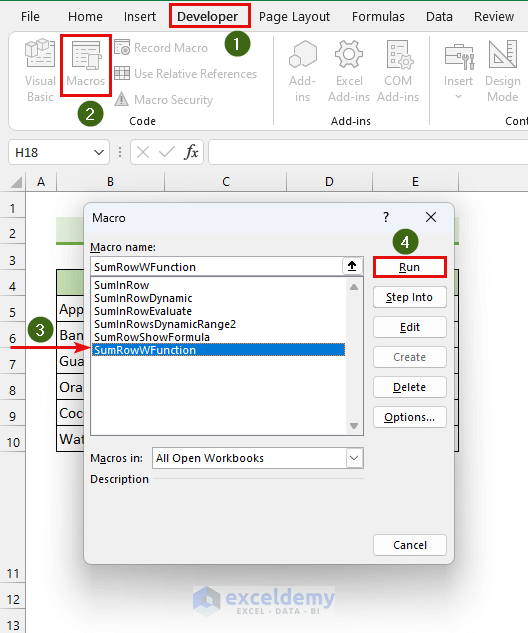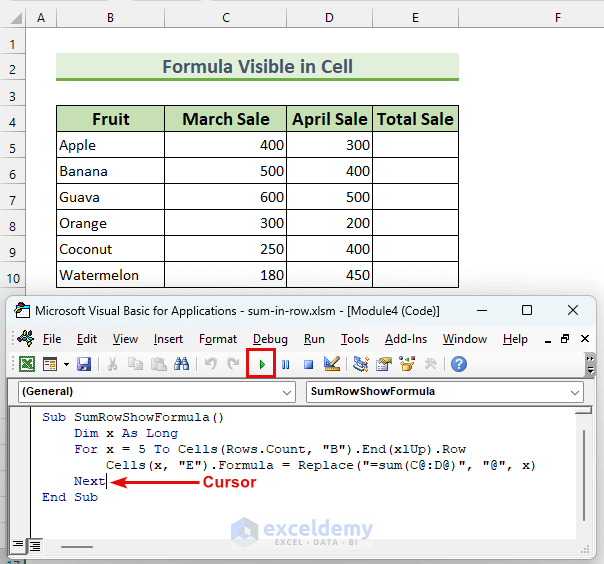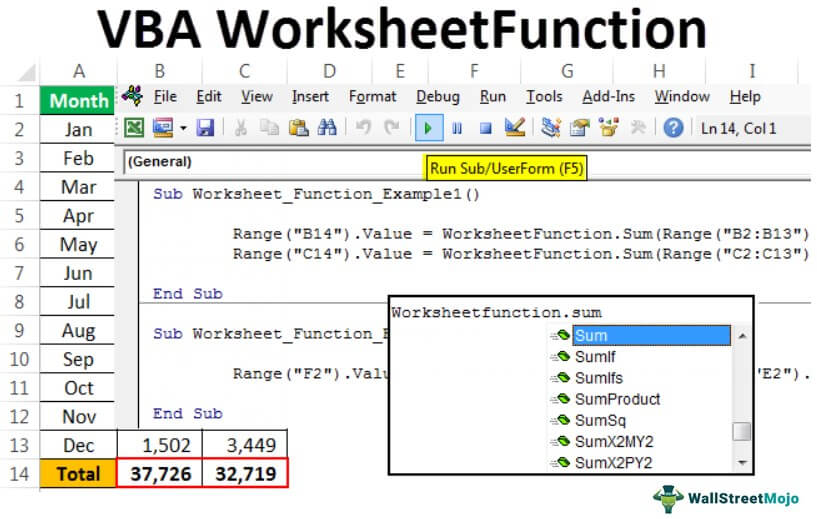Vba Sum A Range
Vba Sum A Range - It is similar to the sum function in excel, but it’s used within vba code to perform calculations. I'm attempting to write a simple vba macro that will take the active cell's column and the user's input to add a range of cells on a single row together. If you want to sum values then use the following: And, in this tutorial, we are going to learn the different ways that we can use this. If you want the formula then use as. Instead of using the worksheetfunction.sum, you can use vba to apply a sum function to a cell using the formula or formular1c1 methods. The vba sum function is a method used to calculate the sum of values in a range or an array. The range is calculated by adding. In excel, you can use vba to calculate the sum of values from a range of cells or multiple ranges. Range(a1).value = application.sum(range(cells(2, 1), cells(3, 2))) edit:
The vba sum function is a method used to calculate the sum of values in a range or an array. Range(a1).value = application.sum(range(cells(2, 1), cells(3, 2))) edit: If you want to sum values then use the following: Instead of using the worksheetfunction.sum, you can use vba to apply a sum function to a cell using the formula or formular1c1 methods. In excel, you can use vba to calculate the sum of values from a range of cells or multiple ranges. And, in this tutorial, we are going to learn the different ways that we can use this. The range is calculated by adding. If you want the formula then use as. It is similar to the sum function in excel, but it’s used within vba code to perform calculations. I'm attempting to write a simple vba macro that will take the active cell's column and the user's input to add a range of cells on a single row together.
The vba sum function is a method used to calculate the sum of values in a range or an array. I'm attempting to write a simple vba macro that will take the active cell's column and the user's input to add a range of cells on a single row together. And, in this tutorial, we are going to learn the different ways that we can use this. The range is calculated by adding. If you want to sum values then use the following: Instead of using the worksheetfunction.sum, you can use vba to apply a sum function to a cell using the formula or formular1c1 methods. It is similar to the sum function in excel, but it’s used within vba code to perform calculations. If you want the formula then use as. Range(a1).value = application.sum(range(cells(2, 1), cells(3, 2))) edit: In excel, you can use vba to calculate the sum of values from a range of cells or multiple ranges.
How to sum a specific range excel VBA Stack Overflow
It is similar to the sum function in excel, but it’s used within vba code to perform calculations. In excel, you can use vba to calculate the sum of values from a range of cells or multiple ranges. I'm attempting to write a simple vba macro that will take the active cell's column and the user's input to add a.
VBA How to Sum Values in Range
If you want to sum values then use the following: The range is calculated by adding. The vba sum function is a method used to calculate the sum of values in a range or an array. In excel, you can use vba to calculate the sum of values from a range of cells or multiple ranges. If you want the.
Excel VBA SUM (Column, Dynamic Range, All Cells Above, Selected Cells)
If you want the formula then use as. It is similar to the sum function in excel, but it’s used within vba code to perform calculations. The vba sum function is a method used to calculate the sum of values in a range or an array. If you want to sum values then use the following: In excel, you can.
How to Sum a Range of Cells in a Row Using Excel VBA (6 Methods)
I'm attempting to write a simple vba macro that will take the active cell's column and the user's input to add a range of cells on a single row together. The range is calculated by adding. If you want to sum values then use the following: Range(a1).value = application.sum(range(cells(2, 1), cells(3, 2))) edit: If you want the formula then use.
How to Sum Range of Cells in Row Using Excel VBA (6 Easy Methods)
Instead of using the worksheetfunction.sum, you can use vba to apply a sum function to a cell using the formula or formular1c1 methods. And, in this tutorial, we are going to learn the different ways that we can use this. I'm attempting to write a simple vba macro that will take the active cell's column and the user's input to.
How to Sum a Range of Cells in a Row Using Excel VBA (6 Methods)
And, in this tutorial, we are going to learn the different ways that we can use this. I'm attempting to write a simple vba macro that will take the active cell's column and the user's input to add a range of cells on a single row together. In excel, you can use vba to calculate the sum of values from.
How to Sum Range of Cells in Row Using Excel VBA (6 Easy Methods)
Instead of using the worksheetfunction.sum, you can use vba to apply a sum function to a cell using the formula or formular1c1 methods. And, in this tutorial, we are going to learn the different ways that we can use this. Range(a1).value = application.sum(range(cells(2, 1), cells(3, 2))) edit: If you want the formula then use as. In excel, you can use.
VBA How to Sum Values in Range
I'm attempting to write a simple vba macro that will take the active cell's column and the user's input to add a range of cells on a single row together. Range(a1).value = application.sum(range(cells(2, 1), cells(3, 2))) edit: Instead of using the worksheetfunction.sum, you can use vba to apply a sum function to a cell using the formula or formular1c1 methods..
VBA Sum Function (Ranges, Columns, More) Automate Excel, 56 OFF
In excel, you can use vba to calculate the sum of values from a range of cells or multiple ranges. If you want the formula then use as. If you want to sum values then use the following: The range is calculated by adding. The vba sum function is a method used to calculate the sum of values in a.
VBA SUM in Excel Examples (Cells, Range, Array), How to Use?
It is similar to the sum function in excel, but it’s used within vba code to perform calculations. The vba sum function is a method used to calculate the sum of values in a range or an array. And, in this tutorial, we are going to learn the different ways that we can use this. Range(a1).value = application.sum(range(cells(2, 1), cells(3,.
The Vba Sum Function Is A Method Used To Calculate The Sum Of Values In A Range Or An Array.
I'm attempting to write a simple vba macro that will take the active cell's column and the user's input to add a range of cells on a single row together. Instead of using the worksheetfunction.sum, you can use vba to apply a sum function to a cell using the formula or formular1c1 methods. If you want the formula then use as. The range is calculated by adding.
If You Want To Sum Values Then Use The Following:
Range(a1).value = application.sum(range(cells(2, 1), cells(3, 2))) edit: It is similar to the sum function in excel, but it’s used within vba code to perform calculations. In excel, you can use vba to calculate the sum of values from a range of cells or multiple ranges. And, in this tutorial, we are going to learn the different ways that we can use this.









